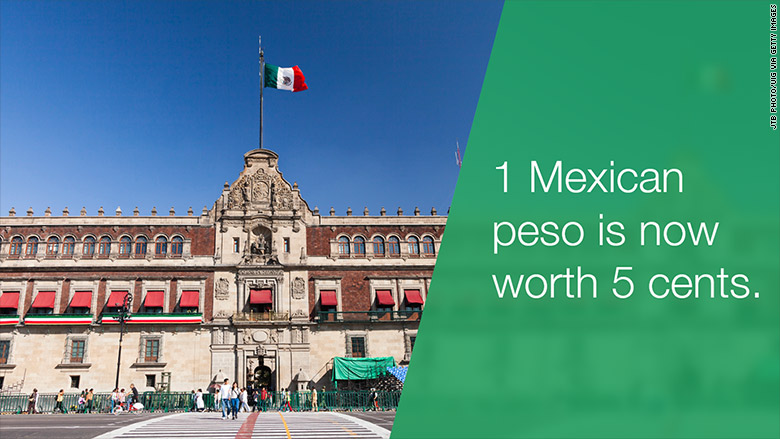
Mexico looks especially cheap these days.
The peso fell to its lowest value ever against the U.S. dollar on Thursday. One Mexican peso is now worth barely more than a nickel ($0.053 cents).
Investors are dumping emerging market stocks and currencies as they flee to assets that appear safer like U.S. government bonds.
"It's not just the peso. The [Russian] ruble hit a record low this week. The [South African] rand last week. It's a broad based sell-off in emerging markets," says Win Thin, global head of emerging markets strategy at Brown Brothers Harriman.
But the Mexican peso has been hit the hardest of them all in 2016.
Related: Russian ruble plunges to record low against dollar
The problem for Mexico is that it's one of the easiest emerging market currency to trade. So investors have been selling it as a proxy for emerging markets overall.
"It's a 'risk off.' People are selling anything that looks risky," says Thin.
Mexico is also suffering from the dramatic crash in oil prices. Crude oil plays a large role in the Mexican economy, accounting for 11% of exports. As oil fell to its lowest level since 2003 on Wednesday, traders soured even more on the Mexico's currency.
Related: Why you should worry about cheap oil?
Mexican leaders have been trying to stop the pain. Mexico's central bank has been intervening in the market by selling dollars and telling anyone who will listen that it believes the peso is oversold.
"My sense is the peso will return from the levels it is right now," Mexico's central bank Governor Agustin Carstens told Bloomberg this week in Davos.
Mexico's economy was one of the best performers in all of Latin and South America last year. Despite all the headwinds, it still grew 2.3%.
The final fear factor driving the peso down is the U.S. Federal Reserve.
The Fed raised interest rates for the first time in nearly a decade in December, heightening concerns that emerging market companies that borrowed in dollars would have an even harder time repaying their debts.


